Experience the Serengeti Like Never Before
The Serengeti is a vast ecosystem located in northern Tanzania and extends into southwestern Kenya, where it is known as the Maasai Mara. It is one of the most iconic wildlife regions in the world, covering approximately 30,000 square kilometers. The name “Serengeti” is derived from the Maasai word siringet, meaning “endless plains,” which perfectly describes the seemingly infinite stretches of grassland that dominate the landscape.
This region is best known for its incredible biodiversity and is home to the largest terrestrial mammal migration in the world—the Great Migration. Each year, over 1.5 million wildebeest, accompanied by hundreds of thousands of zebras and gazelles, move in a circular pattern through the Serengeti and Maasai Mara in search of fresh grazing. This migration attracts numerous predators like lions, leopards, and crocodiles, creating one of the most dramatic and spectacular natural events on the planet.
Apart from the migration, the Serengeti hosts the “Big Five” (lion, elephant, buffalo, leopard, and rhino), and it’s recognized as a UNESCO World Heritage Site due to its ecological significance. It plays a crucial role in conservation, research, and ecotourism in East Africa. Visitors are drawn to the Serengeti not just for the wildlife, but also for its raw natural beauty—sun-drenched savannahs, acacia-dotted horizons, and breathtaking sunsets that offer an unforgettable African safari experience.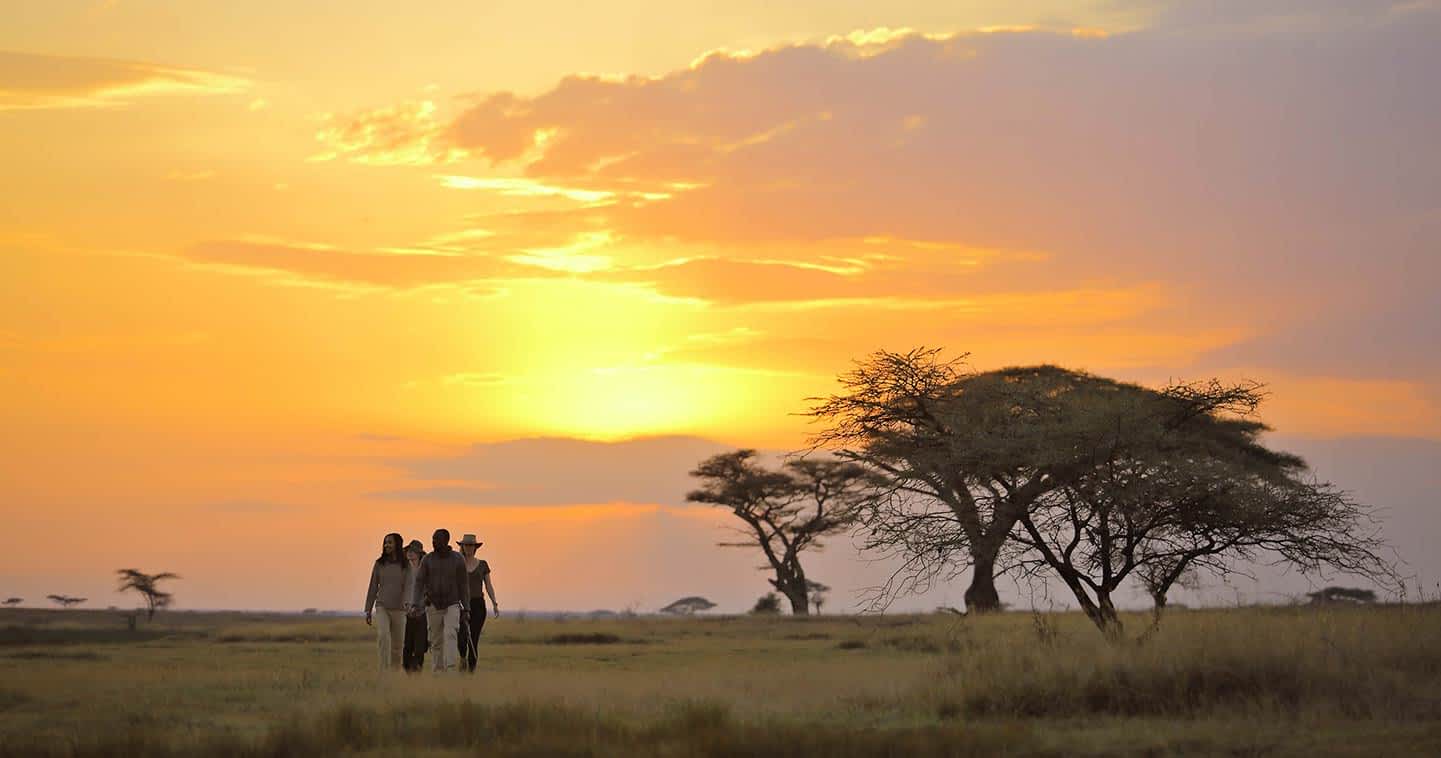
What’s so special about visiting Serengeti?
The Great Migration is one of the most extraordinary natural events on Earth, taking place each year across the vast plains of the Serengeti in Tanzania and the Maasai Mara in Kenya. This epic journey involves over 1.5 million wildebeest, joined by hundreds of thousands of zebras, gazelles, and other grazing animals, as they follow a circular path in search of fresh pasture and water. This migration is driven by seasonal rains and is a constant cycle of movement, survival, and regeneration in the heart of Africa.
Throughout the journey, these animals face numerous challenges and dangers. Predators such as lions, hyenas, cheetahs, and leopards closely follow the herds, taking advantage of the opportunity to hunt. One of the most dramatic moments of the migration is the river crossing, especially at the Grumeti and Mara Rivers, where animals plunge into crocodile-infested waters, often creating a chaotic and awe-inspiring scene. These crossings are among the most photographed and iconic wildlife spectacles in the world.
Beyond its visual drama, the Great Migration plays a vital role in maintaining the ecological balance of the Serengeti-Mara ecosystem. The movement of the herds supports nutrient cycling in the soil and helps maintain healthy grasslands. For travelers, witnessing this event is a breathtaking reminder of the raw power and beauty of nature—a true bucket-list experience that showcases wildlife at its most wild and free.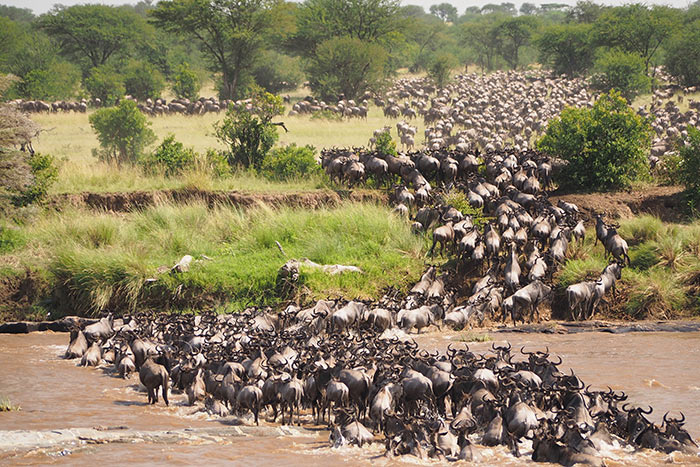
The Serengeti is renowned for its incredible wildlife, offering one of the most diverse and concentrated animal populations on the planet. It is home to the legendary Big Five—lion, leopard, elephant, buffalo, and rhino—as well as cheetahs, giraffes, hyenas, hippos, jackals, and countless other species. The open plains make it easy to spot wildlife, whether you’re on a game drive at dawn or watching animals gather around a watering hole in the late afternoon. The sheer abundance and variety of species create an unforgettable safari experience for first-time visitors and seasoned explorers alike.
In addition to the mammals, the Serengeti hosts over 500 bird species, from colorful lilac-breasted rollers to powerful birds of prey like eagles and vultures. The region’s balanced ecosystem allows for rich interactions between predator and prey, offering countless moments of awe—from a pride of lions resting under an acacia tree to a stealthy leopard perched in the branches above. With each drive through the Serengeti, you witness the rhythm of the wild, where every creature plays a role in one of the most fascinating natural theaters on Earth.
The Serengeti is not only rich in wildlife but also breathtaking in its landscapes, offering endless golden savannahs, rolling grasslands, scattered acacia trees, and dramatic rock outcrops known as kopjes. As the sun rises and sets, the skies explode with color, casting warm hues across the horizon and creating postcard-perfect scenes at every turn. Whether you’re watching a herd of elephants silhouetted against the glow of dawn or gazing over the vast plains from a hilltop, the Serengeti’s natural beauty leaves a lasting impression of peace, wonder, and wild African majesty.
A visit to the Serengeti isn’t complete without connecting with the rich and vibrant cultures that call this region home—most notably, the Maasai people. Known for their distinctive red clothing, beadwork, and centuries-old traditions, the Maasai have lived in harmony with the wildlife of the Serengeti for generations. Visitors can engage in cultural tours to Maasai villages (manyattas), where they learn about daily life, traditional customs, livestock herding, and the deep spiritual connection the Maasai have with the land and animals around them.
These cultural experiences offer a meaningful perspective beyond the wildlife and landscapes, adding depth to your journey through East Africa. From participating in traditional dances to witnessing fire-making and storytelling, travelers gain a unique appreciation for the resilience and wisdom of indigenous communities. It’s a powerful reminder that the Serengeti isn’t just a sanctuary for animals, it’s also a living, breathing home for people whose heritage is deeply rooted in the natural rhythms of this land.
The Serengeti offers a range of luxury and eco-friendly lodging options that blend comfort with nature, providing an unforgettable stay in the heart of the wild. From high-end safari lodges with infinity pools and fine dining to intimate tented camps that let you fall asleep to the sounds of the bush, each accommodation is thoughtfully designed to immerse guests in the landscape without compromising on sustainability or style. Many lodges are solar-powered, locally staffed, and committed to conservation, giving travelers the chance to enjoy world-class hospitality while supporting the protection of the Serengeti’s ecosystem.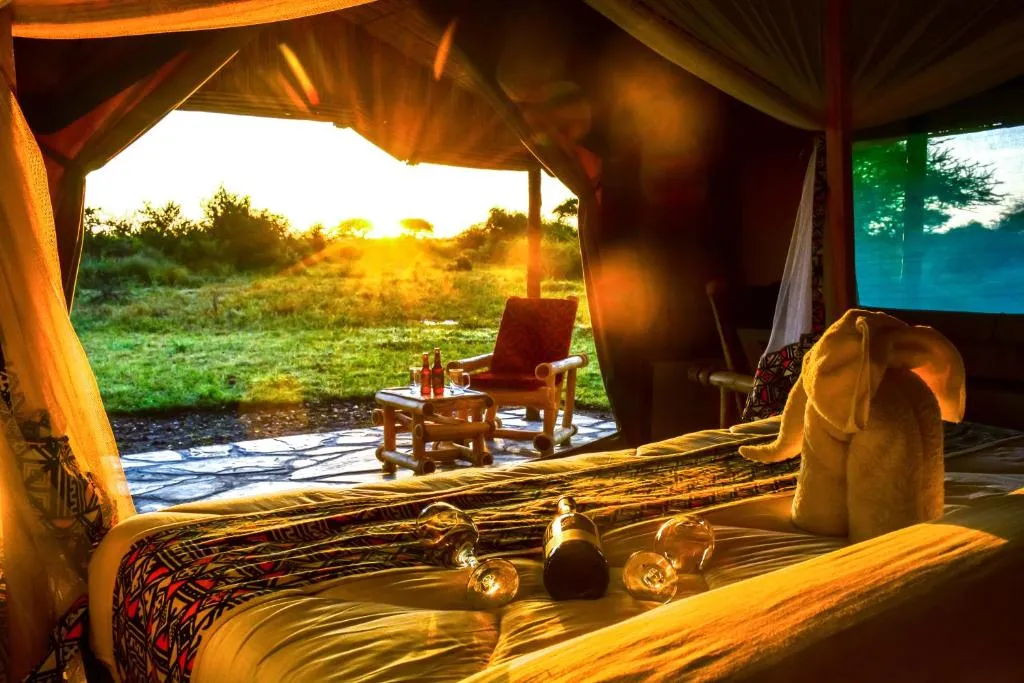
A balloon safari over the Serengeti is one of the most exhilarating and unique ways to experience this incredible landscape. As the sun rises, passengers are lifted into the air in a hot air balloon, offering an unparalleled bird’s-eye view of the vast savannahs, winding rivers, and herds of wildlife below. The silence and serenity of floating above the plains, combined with the sight of elephants, lions, and wildebeest from above, creates an unforgettable experience, perfect for photographers and nature lovers alike. The early morning light casts a golden glow across the landscape, enhancing the sense of magic and wonder.
After a thrilling flight, many balloon safaris include a celebratory champagne breakfast in the bush, providing a perfect conclusion to this once-in-a-lifetime experience. Balloon safaris are a more intimate way to witness the Serengeti’s natural beauty and wildlife, offering perspectives that you can’t get from a traditional game drive. It’s a serene yet thrilling way to connect with the region’s untamed spirit, combining the excitement of adventure with the peace of the African wilderness.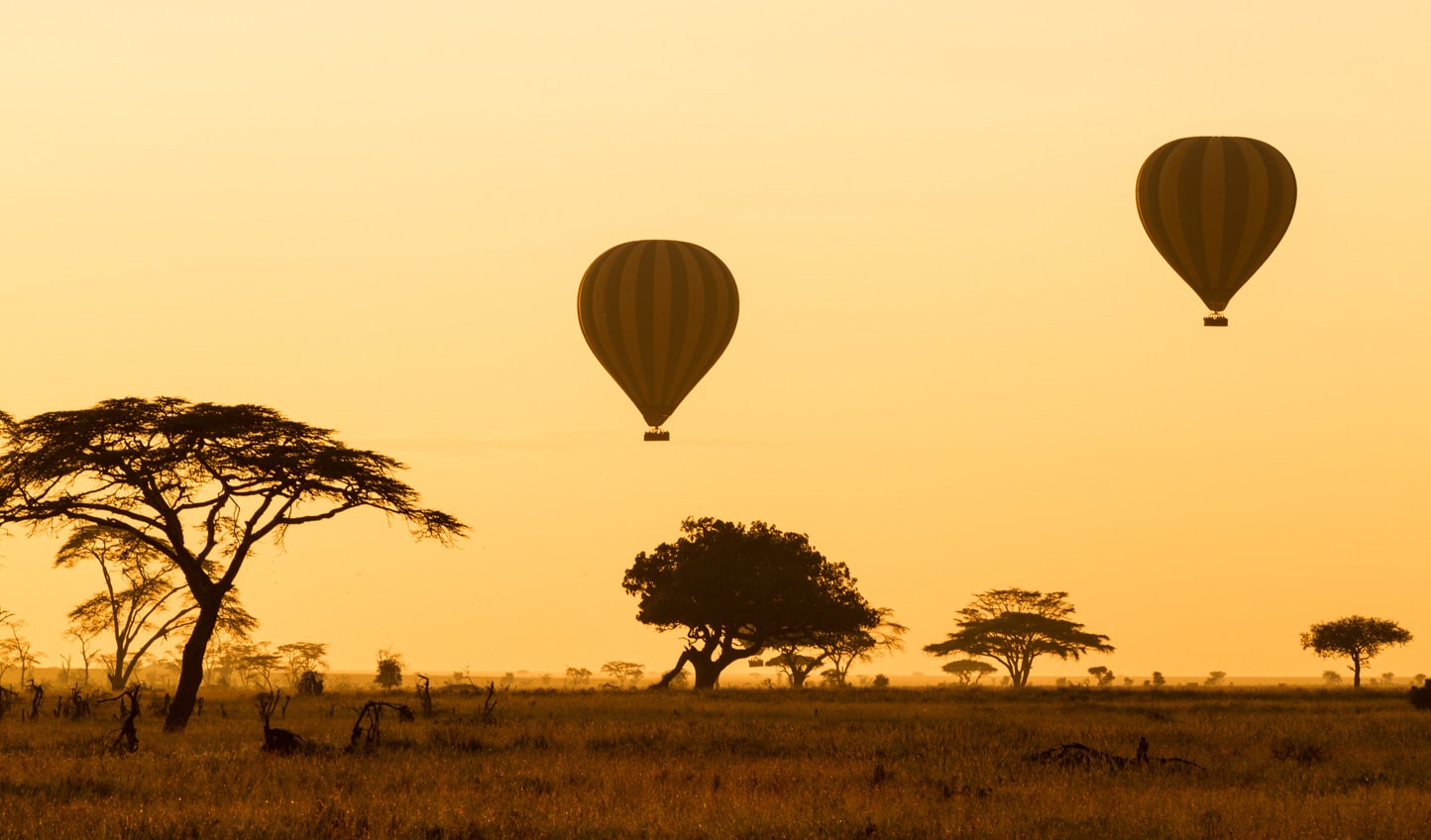
The Serengeti is a sanctuary of unspoiled nature, where vast expanses of untouched wilderness remain largely free from human development. This pristine environment allows wildlife to thrive in its natural rhythms, from the seasonal migration of animals to the subtle interactions between predator and prey. The lack of urban interference means that visitors can experience the raw, untamed beauty of Africa, where every sunrise and sunset, every rustle in the grass, and every distant roar of a lion feels pure and authentic—an unforgettable escape into the heart of nature.
What’s the ideal time to experience the Serengeti’s wildlife and landscapes?
The ideal time to experience the Serengeti’s wildlife and landscapes depends on what you want to see. If you’re aiming to witness the Great Migration, the best time is from June to October, when the herds are moving through the northern Serengeti and crossing into the Maasai Mara. This period is also great for spotting predators, as they follow the herds in search of prey, creating dramatic scenes.
For a more peaceful safari experience, with fewer crowds and excellent game viewing, the January to March window is ideal. During this time, the herds gather in the southern Serengeti, where they give birth to their young. It’s a perfect opportunity to see newborn animals and the tender interactions between mothers and calves. The landscape during this period is lush and green from the recent rains, offering vibrant, picturesque views of the plains.
What types of accommodation are available in the Serengeti?
In the Serengeti, accommodations cater to a wide range of preferences, from luxurious lodges to more modest camping options. Luxury lodges offer an all-inclusive experience with elegant rooms, fine dining, and exceptional service. These lodges are often strategically placed in prime wildlife viewing areas such as the central Serengeti or near river crossings, ensuring guests enjoy close encounters with the animals. Many luxury lodges come with indulgent amenities like infinity pools, spas, and private verandas, allowing visitors to relax in comfort while soaking in the stunning views of the savannah. For those seeking an intimate, yet still upscale, safari experience, tented camps offer luxury tents with en-suite bathrooms and sometimes even private plunge pools, often set up during the Great Migration.
For travelers who prefer a more eco-conscious stay, eco-friendly lodges and camps are widely available. These accommodations are designed with sustainability in mind, often using solar power, water conservation techniques, and employing local staff to ensure minimal environmental impact. For those on a tighter budget, campsites provide a more rustic experience, typically located in public campsites near park entrances or within the Serengeti’s boundaries. These simpler options allow for a more authentic, budget-friendly experience where guests can sleep under the stars and truly immerse themselves in the natural beauty of the Serengeti. Regardless of your accommodation choice, the Serengeti offers a memorable stay in one of the world’s most captivating ecosystems.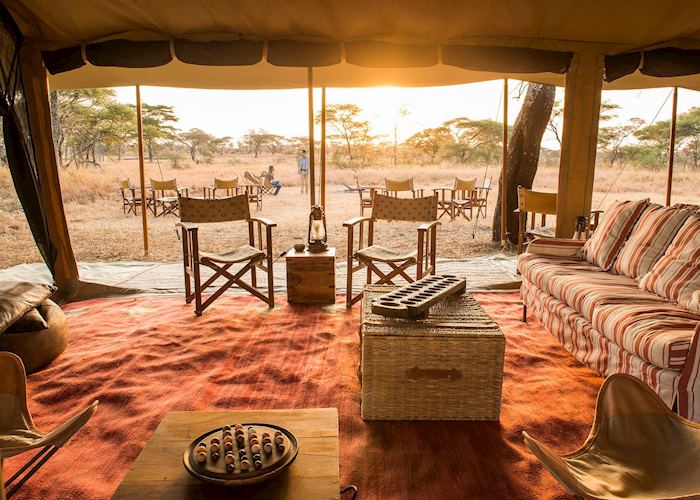
Hodophile Adventures offers accommodations ranging from rustic tented camps to luxurious safari lodges, each selected for comfort, location, and immersive wildlife experiences. Imagine sipping your morning coffee as elephants stroll past your veranda!
Ready to answer the call of the wild? Whether you’re a first-time safari-goer or a seasoned adventurer, Hodophile Adventures crafts unforgettable Serengeti experiences with a personal touch.









